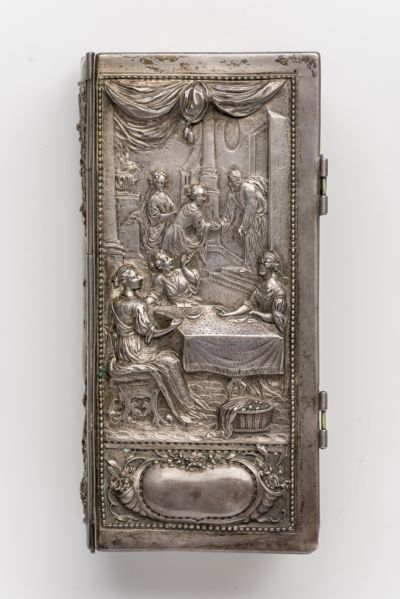
Prayerbook - Das Andaechtige und In Jesum inbruenstig Verliebte Frauenzimmer, Leipzig, 1700.
| Accession Nr.: | 19128 |
|---|---|
| Place of production: | Leipzig |
| Inscription: | nincs |
|---|---|
| Materials: | silver; wooden board |
| Techniques: | cast; chased; chiselled |
| Dimensions: |
height: 15,6 cm
width: 7,5 cm
weight: 458 g
|
On the front page of the prayer book for women the wise virgins, and on the rear page, the foolish virgins are to be seen. The plates are attached with hinges to the spine, which is ornamented with an empty cartouche with horns of plenty, jugs, floral and fruit motifs. The spine is covered with chased ornaments resembling the floral and scroll ornaments of the cast hinge the tympanum is missing. The book is stitched on three parchment bands and the cut is gilt. The flyleaf is a later addition, red-orange-blue-green marbled. On the title page of the binding three of the wise virgins are reading with the night-light two of them receive Christ. On the rear cover, the foolish virgins are playing cards and music, and gossiping, the oil-lamp is on the ground, over turned. Both scenes are framed with curtains of drapery above and an empty cartouche flanked by horns of plenty.
The engravings of the prayer book are ornamented with the same motifs - these are the title pages of the different chapters with representations referring to the content and titles written in cartouches. There are no exact facts about the engravings, and not much is known about the models for the representations on the cover. On his tankard (Inv.nr. 19123) Daniel Stahlenbrecher, a goldsmith of Elbing used a similar model for the representation of the foolish virgins, but the source of the other scene is different. The various scenes, compared to those of the book binding, are less detailed. The reason for this may be not only the different size of the book, but also problems of interpretation originating from the complexity of the iconography. These were the causes of the uncertainties of form, and certain changes, such as the omission of the mirror motif, which had an important meaning, or the appearance of a cottage in the scene of the wise virgins.
Literature
- Szerk.: Lovag Zsuzsa: Az Iparművészeti Múzeum. (kézirat). Iparművészeti Múzeum, Budapest, 1994. - Nr. 283.
- Szerk.: Szilágyi András, Péter Márta: Barokk és rokokó. Az európai iparművészet stíluskorszakai. Iparművészeti Múzeum, Budapest, 1990. - Nr. 4.33. (Prékopa Ágnes)
- Szerk.: Rómer Flóris: Képes kalauz a Magyar Nemzeti Múzeum Érem- és Régiségtárában. Athenaeum Kiadó, Budapest, 1873. - 46.






